Earth is the third planet from the Sun and the fifth largest planet in the Solar System with the highest density. It is currently the only known location where life is present.
Key Facts & Summary
- The realization that Earth is a planet, and a planet among many others was established “fairly” recently, in the 17th century – this realization came through by the combined forces of ancient philosophers, mathematicians, and astronomers.
- Plato correctly deduced that the Earth is spherical but this idea would take root and be proven much later.
- The name “Earth” – is at least 1.000 years old, and it is a Germanic word which simply translates to “the ground.” It is not known who came up with it but it is the only planet that wasn’t named after a Greek or Roman god.
- However, the Greek equivalent to Earth is Gaia – terra mater – mother Earth, and Roman equivalent was Tellus – the fertile soil.
- Earth is estimated to have formed around 4.5 billion years ago – almost one-third of the age of the universe – through accretion from the solar nebula.
- Earth is the third planet from the Sun, at a distance of 1 AU or 147 million km / 91 million mi.
- It is the fifth-largest planet in the Solar System, being the largest of the terrestrial planets.
- It has an equatorial radius of 6.371 km / 3.958 mi, and a polar radius of 6.356 km / 3.949 mi, meaning it is not completely spherical but rather bulged at the equator due to rotation.
- The Earth has a diameter of 12.742 km / 7.917 mi.
- Earth has a mass of about 6.6 sextillion tons and a volume of about 260 billion cubic miles / 1 trillion cubic kilometers.
- The surface area of Earth is about 197 million square miles / 510 million square kilometers.
- Around 71% of the surface is covered by water and 29% by land.
- The water is 3% fresh and 97% salted. Of that 3% freshwater, over 2% is frozen in ice sheets and glaciers meaning that less than 1% is freshwater found in lakes, rivers, and the underground.
- In regards to land, the continent of Asia covers about 30% of all the land, having around 60% of the world’s population.
- The atmosphere of Earth is composed of roughly 78% nitrogen, 21% oxygen, 0.97% argon and carbon dioxide and about 0.04% other gases and water vapor. The mixture of gases is commonly known as air.
- The thickness of the atmosphere is about 60 miles / 96 kilometers.
- The atmosphere of Earth is divided into 6 layers: troposphere, stratosphere, mesosphere, thermosphere, exosphere, and ionosphere.
- The highest temperatures on Earth can reach up to more than 110 degrees Fahrenheit / 48 degrees Celsius, and the lowest around -126 degrees Fahrenheit / -88 degrees Celsius, maybe even lower.
- Earth has the greatest density out of all the planets in the solar system - 5.51 g/cm³ - and a gravity of 9.807 m/s² or 1 g.
- This suggests that the Earth’s core is solid, made of iron and nickel about 759 miles / 1.221 kilometers in radius. The temperatures at the core have been estimated to be around 9.800 degrees Fahrenheit / 5.400 degrees Celsius. This is hotter than the surface of the Sun.
- Together with the inner core, Earth also has an outer core, with the crust being the mantle and the thickest layer. It is a viscous mixture of molten rock about 1.800 mi / 2.900 km thick and has the consistency of caramel.
- The outermost layer – Earth’s crust – goes about 19 mi / 30 km deep on average on land. But at the bottom of the ocean, the crust is thinner and extends about 3 mi / 5 km from the seafloor to the top of the mantle.
- Earth has only one satellite – the Moon – and a couple of temporal artificial satellites.
- Earth’s axis is tilted 23.5 degrees from the plane of its orbit around the Sun. The tilt varies between 22.1 and 24.5 degrees, causing seasons and even chaotic seasons. It changes positions once every 40.000 years.
- Earth completes a rotation/day – from West to Est - once every 23.9 hours. One orbit/year – a trip around the Sun – is completed within 365 days. The Earth’s orbit is elliptical or oval-shaped.
- Earth’s magnetosphere acts as a shield against solar and cosmic particle radiation. It has the shape of a tear-drop reaching 36.000 mi / 57.936 km into space, and it is one of the reasons life has managed to develop.
Since ancient times the Earth was taught to be at the center of the Universe with the other celestial objects orbiting around it. Some believed that the Earth was flat, while the ancient Greeks such as Plato correctly deduced that the Earth was a sphere.

Soon after, the Greek astronomer Ptolemy proposed the idea that planets were in tiny spheres and made circles as they orbited Earth.
In the 16th century, the Polish mathematician/astronomer Nicolaus Copernicus created the heliocentric model of the Solar System – where everything orbited the Sun.
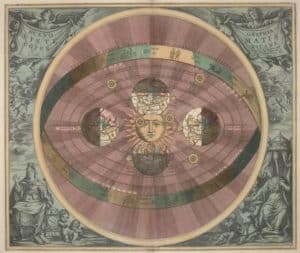
Later, in the 17th century, Galileo Galilei observed and discovered Jupiter and that it had moons of its own, and that Venus went through phases like the Moon.
Observations continued, ideas caught up and finally, it was established that Earth was a planet among many others. The name of our planet came from the Anglo-Saxon word “erda” and the Germanic word “erde” – they both mean soil or ground.
The old English version of these words became “eor(th)e” or “ertha”, which later transformed into “Earth.” Many other languages use some form of variation or naming of their own such as: Aarde, Terre, Tera, Jorden, Nchi, Bumi, and many more. We who inhabit Earth can be referred to as: Earthlings, Earthers, Terrans or Gaians.
Formation
The Earth is believed to have formed around 4.5 billion years ago. The duration for this formation has been estimated to have lasted about 10 to 20 million years.
The theory states that a solar nebula partitions a volume out of a molecular cloud by gravitational collapse which begins to spin and flatten into a circumstellar disk.
The planets grow out of that disk through gravity pulling swirling dust and gas. Slowly, the Earth’s atmosphere and oceans were formed by volcanic activity and outgassing.
It is believed that water vapor condensed into the oceans being augmented by water and ice from asteroids, protoplanets, and comets.

The atmospheric greenhouse kept the oceans from freezing when the newly formed Sun had only 70% of its current luminosity. When the Earth’s magnetic field was established it helped to prevent the atmosphere from being stripped away by the solar wind.
A crust formed when the molten outer layer of Earth cooled to form a solid. There are two models who propose that the landmass steadily grew to present-day forms, or, more likely that it grew rapidly early in Earth’s history, followed by a long-term steady continental area. The continuous loss of heat from Earth’s interior, helped continents form through - plate tectonics.
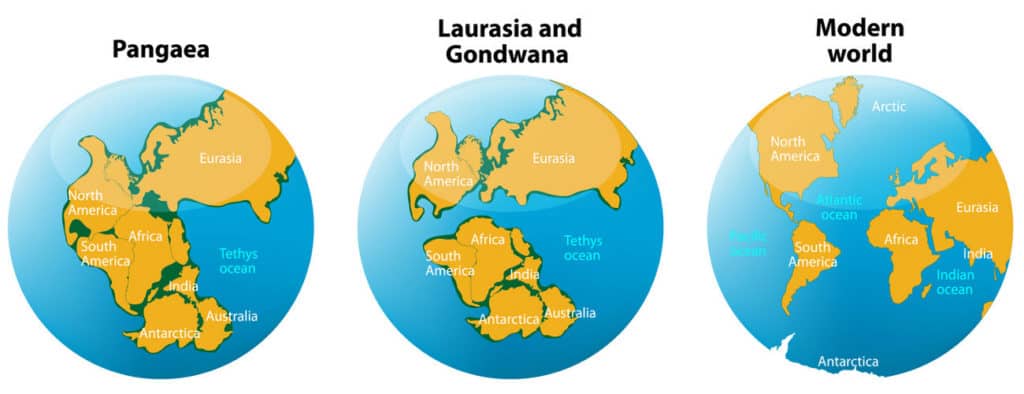
Through periods of hundreds of millions of years, the supercontinents have assembled and then broke apart. About 750 million years ago, the earliest known supercontinent Rodinia began to break apart.
The continents later rejoined and combined again to form Pannotia about 600 to 540 million years ago. This happened again and the supercontinent of Pangaea formed but also broke apart about 180 million years ago.
There are patterns that suggest that ice ages began about 40 million years ago and intensified during the Pleistocene around 3 million years ago. Many high-latitude regions have undergone repeated cycles of glaciation and thaw, repeating about every 40.000 to 100.000 years. It is believed that the last continental glaciation ended 10.000 years ago.
Distance, Size and Mass
Earth is the third planet from the Sun, at a distance of 1 AU or 147 million km / 91 million mi. It is situated in the goldilocks zone where temperatures are just right for liquid water to exist and for life to evolve.
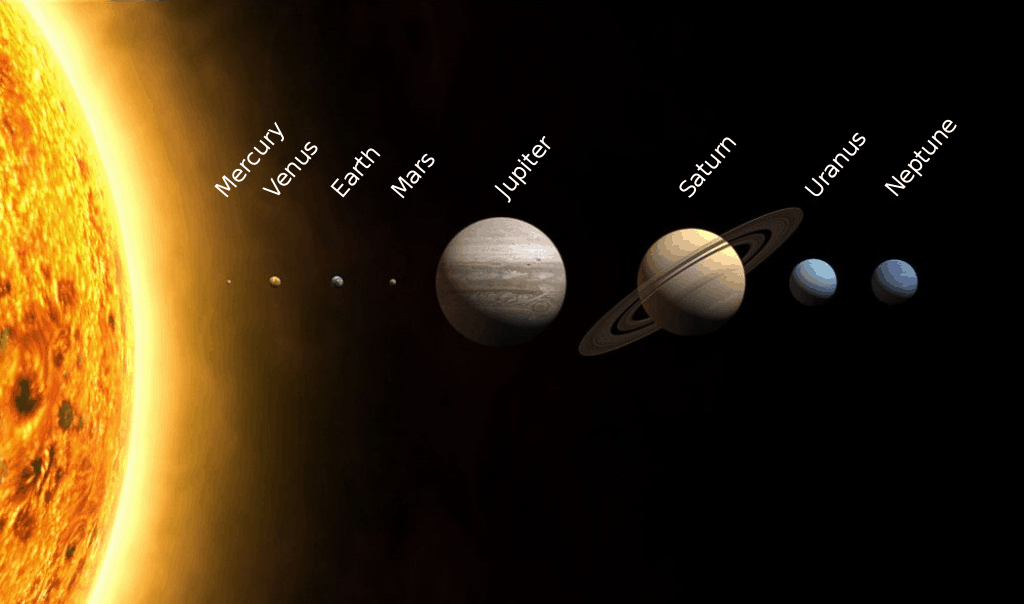
Depending upon their current orbital positions, either Venus or Mercury are the closest planets to Earth. It has an equatorial radius of 6.371 km / 3.958 mi, and a polar radius of 6.356 km / 3.949 mi, meaning it is not completely spherical but rather bulged at the equator due to rotation.
The diameter of Earth is around 12.742 km / 7.917 mi being the fifth largest planet from the solar system, and the largest of the terrestrial planets (Venus, Mercury, Mars).
The Earth is so big that if it were hallowed, almost 50 moons could fit inside it. Earth has a mass of about 6.6 sextillion tons and a volume of about 260 billion cubic miles / 1 trillion cubic kilometers. It has the biggest mass out of all the terrestrial planets and the greatest density out of all the planets - 5.51 g/cm³. Earth’s mass composition is mostly comprised of iron 32.1%, oxygen 30.1%, silicon 15.1%, magnesium 13.9%, sulphur 2.9%, nickel 1.8 %, nickel 1.8%, calcium 1.5%, and aluminum 1.4%. The remaining 1.2% consists of trace amounts of other elements.
Orbit and Rotation
The Earth makes a complete rotation on its axis once every 23.9 hours. It takes Earth 265,25 days to complete one trip around the Sun – year. In order for calendars to maintain their consistency with this orbit, every 4 years one day is added – this is called a leap day – as well as a leap year.

Earth's orbital speed averages 29.78 km/s (107,208 km/h; 66,616 mph), which is fast enough to cover the planet's diameter in 7 minutes and the distance to the Moon in 4 hours.
Structure - Geology
Earth has four major main layers: an inner core at the center, an outer core enveloping it, mantle, and crust.

Since it has the greatest density out of all the planets in the solar system - 5.51 g/cm³ - and a gravity of 9.807 m/s² or 1 g the Earth’s core is solid. It is made of iron and nickel about 759 miles / 1.221 kilometers in radius. The temperatures at the core have been estimated to be around 9.800 degrees Fahrenheit / 5.400 degrees Celsius. This is hotter than the surface of the Sun.
Together with the inner core, Earth also has an outer core, with the crust being the mantle and the thickest layer. It is a viscous mixture of molten rock about 1.800 mi / 2.900 km thick and has the consistency of caramel.
The outermost layer – Earth’s crust – goes about 19 mi / 30 km deep on average on land. But at the bottom of the ocean, the crust is thinner and extends about 3 mi / 5 km from the seafloor to the top of the mantle. The crust in a sense floats on the mantle due to lower density.
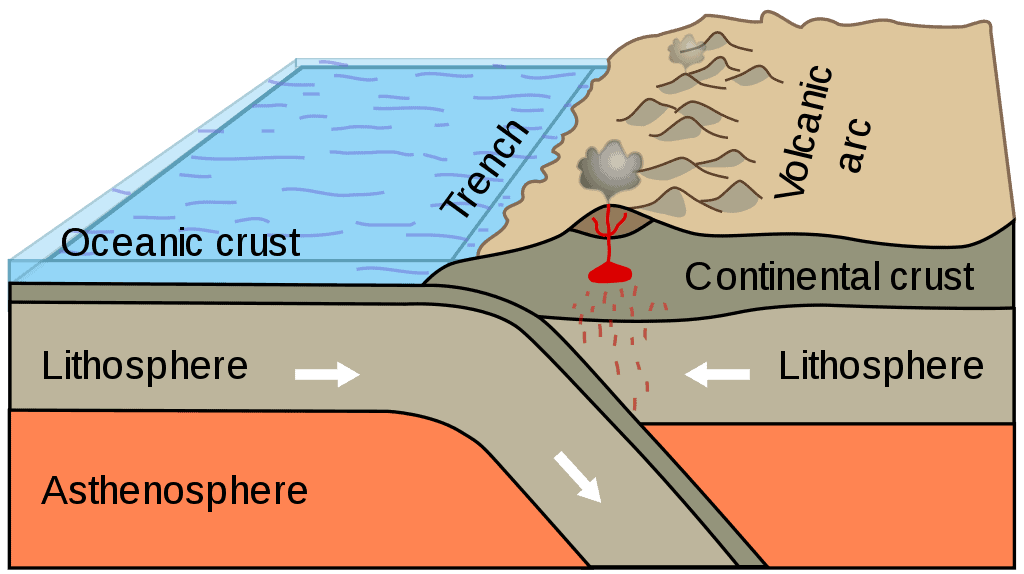
It is not a solid piece but rather broken up into huge tectonic plates. These plates move, driven by the flow of rock in the mantle that is in turn powered by heat.
The core heats the bottom of the mantle causing convection leading to the warmer material to rise. It takes about 50.000 to 60.000 years for a blob to move a single kilometer.
Though the hot material rises towards the surface, it is blocked by the crust. The magmatic rock pushes on the plates, causing them to slide around slowly.
Over millions of years, the surface geology of the Earth changed dramatically because of this. Where the crust is weaker magma can push its way through thus erupting onto the surface, forming volcanoes.
Because of volcanoes, material wells out creating new land, and they also pump out gas that greatly contributed to Earth’s atmosphere.
The interior of the Earth is very hot – comparable to the surface of the Sun. Most of the heat has remained since the Earth’s formation. As it gained mass it began to contract under its own gravity - the squeezing adding heat to the material. Elements like uranium also contribute to the Earth’s heat as the atoms radioactively decay.
Another source for the heat: dense materials such as iron and nickel that sunk to the center, warming up due to friction.
As such the core is so hot because of:
- Leftover heat since the Earth’s formation
- Gravity’s squeezing effect
- Radioactive decay from elements such as uranium
- Friction
The surface of the Earth is constantly moving. Molten lava rises from beneath the surface and moves into the gap that is created. The new rock helps push the plates apart and as it cools, it becomes part of the continually regenerating crust.
When the ocean plates meet the continental plates they are forced downward. This creates friction beneath and pressure forces molten rock upward to erupt to the crust as ash and lava.

Many volcanoes formed this way but there is a second type of collision: when two continental plates converge as one plate slides under the other the lighter mass at the surface thrusts and folds upward forming mountain chains.
The third type of plate interaction occurs where plates meet at oblique angles to each other. Pressure and friction between the surfaces prevent slippage and when the tension becomes too great the plates shift, sliding along a fault line. Sometimes, violent tremors result and cause the widespread destruction of an earthquake.
Surface
The surface area of Earth is about 197 million square miles / 510 million square kilometers. Around 71% of the surface is covered by water and 29% by land.
The water is 3% fresh and 97% salted. Of that 3% freshwater, over 2% is frozen in ice sheets and glaciers meaning that less than 1% is freshwater found in lakes, rivers, and the underground.
In regards to land, the continent of Asia covers about 30% of all the land, having around 60% of the world’s population. The Earth is divided into 7 continents that constantly “move” several centimeters every year. In about 250 million years about four fundamental scenarios for the formation of the next supercontinent have been hypothesized: Novopangea, Pangea Ultima, Aurica and Amasia.
Novopangea seems the most likely scenario based on current evaluations. The Americas would collide with the northward drifting Antarctica, and then into the already collided Africa-Eurasia.

The highest altitude – elevation - on Earth is Mount Everest at 8,848 m \ 29,029 ft above sea level. The lowest point on land is in the Dead Sea – 420 m / 1.377 ft below sea level. The average depth of the global ocean is about 2.5 miles / 4 kilometers. Most volcanoes are hidden under these oceans. Hawaii’s Mauna Kea is a volcano much taller than Mount Everest, and even Earth’s longest mountain range – four times longer than the Andes, Rockies, and Himalayas combined – is underwater at the bottom of the Arctic and Atlantic oceans.
The shape of the Earth is nearly spherical. There is a small flattening at the poles and bulging around the equator due to Earth's rotation speed. This makes the shape of Earth approximately an oblate spheroid. The point on the surface farthest from Earth's center of mass is the summit of the equatorial Chimborazo volcano in Ecuador.

Atmosphere
The atmosphere of Earth is a layer of gas above the crust. It is not solid and thus it fades away with height. The line between Earth’s atmosphere and space is set at 100 km / 62 miles up. It is called the Kármán line. Technically, anyone, who goes above it is an “astronaut.”

The atmosphere by volume is about 78% nitrogen, 21% oxygen, 1% argon, and the rest an assortment of trace gases. Water vapor is also present, almost all of it below a height of about 8-15 km/ 4.9 – 9 mi.
This part of the atmosphere is the warmest at the bottom, creating convection in the air that in turn creates currents of rising air. They carry water, forming clouds, which in turn is why we have weather.
The ozone layer is situated at a height of 25 km / 15.5 mi on average. This is a molecule of oxygen that absorbs very well solar ultraviolet light. This type of light is dangerous to biological molecules thus the ozone layer is critical for our protection and survival.
The atmosphere of Earth can be divided into 6 major layers:
(1). Troposphere – The lowest starting at ground level and extending upward to about 10 km / 6.2 miles. Most of the weather occurs here and most clouds are present.
(2). Stratosphere – It extends from the top of the troposphere to about 50 km / 31 mi above the ground. This is where the ozone layer is present. Unlike the troposphere, it gets warmer upwards this means a lack of turbulence favorable to commercial jet plane rides.
(3). Mesosphere – It extends upward to a height of about 85 km / 53 miles above the planet. Most of the meteors burn up in the mesosphere and unlike the stratosphere, the temperature drops again with the top temperature reaching about -90 degrees Celsius / -130 degrees Fahrenheit. The air here is far too thin to breathe and the pressure is well below 1% of the pressure at sea level.
(4). Thermosphere – A layer with very rare air and high-energy X-rays and radiation from the Sun being present but absorbed by the thermosphere. This raises the temperatures considerably and most satellites orbit the Earth in this layer. The auroras, Northern and Southern Lights, occur in the thermosphere. The top of the thermosphere varies between 500-1.000 km / 311-621 mi above the ground.
(5). Exosphere – Considered the final frontier of Earth’s gaseous envelope. The air here is extremely thin and leaks into space. The top once again varies: 100.000-190.000 km / 62.000-120.000 mi above the surface of Earth. The latter value is about halfway to the Moon.
(6). Ionosphere – It is not a distinct layer as the previous ones. It is rather a series of regions in parts of the mesosphere and thermosphere where high-energy radiation from the Sun has knocked electrons loose from their parent atoms and molecules. The electrically charged atoms & molecules are called ions endowing this region with some special properties.
Magnetosphere
Earth’s outer core is made from liquid metal which conducts electricity. The liquid convects, and this motion generates magnetic fields. Earth’s rotation helps organize this motion into huge cylindrical roles that align with the Earth’s axis.

This generates a magnetic field similar to a bar magnet, with a magnetic north pole and south pole. This field surrounds the Earth and deflects most of the charged particles from the solar wind. Without this geomagnetic field, the solar wind would directly hit Earth’s atmosphere eroding the air away.
Mars doesn’t have a strong magnetic field, and it is believed that because of this its atmosphere is mostly vanquished.
Some solar wind particles are trapped by Earth’s magnetic field and are channeled down into the atmosphere. There, they are slammed into air molecules about 150 km / 93.2 mi up. This energizes the molecules, which respond by emitting light in different colors. This glow is called aurora.

The auroras happen near the geomagnetic poles, far north and south. They form ribbons and sheets, depending on the shape of the magnetic field.
Analysis revealed that a magnetic reversal takes place once every 40.000 years on average. When it will happen, compass needles would likely point in many different directions for a few centuries while the switch is being made. After this, the south will become north and vice versa.
Axial Tilt
The Earth orbits around the Sun with one pole constantly tilted towards it. This tilt results in how much light reaches a given point on the surface of Earth. Earth’s axis is tilted towards the ecliptic of the Sun at approximately 23.4 degrees. This is responsible for Earth’s seasonal changes and the diurnal cycle.

Hydrosphere
Earth is currently the only known planet with water on the surface. Referred to as the “Blue Planet”, Earth’s hydrosphere consists chiefly of oceans, inland seas, lakes, rivers, and underground waters down to a depth of 2.000 m / 6.600 ft.

The deepest underwater location is the Challenger Deep of the Mariana Trench in the Pacific Ocean with a depth of 10.911 m / 35.799 ft. The mass of the oceans represents about 1/4400 of Earth’s total mass.
Habitability - Biosphere
Life forms inhabit ecosystems, whose total is sometimes said to form a biosphere. The evolution of the biosphere is speculated to have begun about 3.5 Gya. The biosphere is divided into biomes, inhabited by broadly similar plants and animals. In 2016, scientists reported identifying a set of 335 genes from the last universal common ancestor (LUCA), of all organisms living on Earth.
The origin of life on Earth is still disputed. There are 2 major standing theories that suggest that life developed here from chemical reactions or that life was brought here by a process named panspermia.

Chemical reactions led to the first self-replicating molecules about 4 billion years ago. Half a billion years later, the last common ancestor of all current life arose.
Photosynthesis allowed the Sun’s energy to be directly harvested by life forms. The resultant molecular oxygen accumulated in the atmosphere and due to interaction with ultraviolet solar radiation formed a protective ozone layer in the upper atmosphere.
Smaller cells incorporated into larger ones and resulted in the development of complex cells called eukaryotes. Among the earliest fossil evidence for life is microbial mat fossils found in 3.48 billion years old sandstone in Western Australia.
The panspermia theory suggests that life exists throughout the Universe, distributed by space dust, meteoroids, asteroids, comets, and also spacecraft carrying unintended contamination by microorganisms.

Basically, organisms such as extremophiles can become trapped in debris ejected into space after collisions between planets and other small objects. These organisms may travel dormant until arriving at suitable planets that host suitable conditions for life to thrive and evolve.
Cartography
About 80% of Earth’s oceans haven’t been mapped, and about 65% of the Earth remains unexplored. There are no maps that can actually accurately portray the Earth. The most well-known model – the Mercator – is flawed because the linear scale increases with latitude.
This distorts the size of geographical objects far from the equator and conveys a distorted perception of the overall geometry of the planet.
Probably the most accurate map is the AuthaGraph World Map because it folds the Earth into a three-dimensional globe.
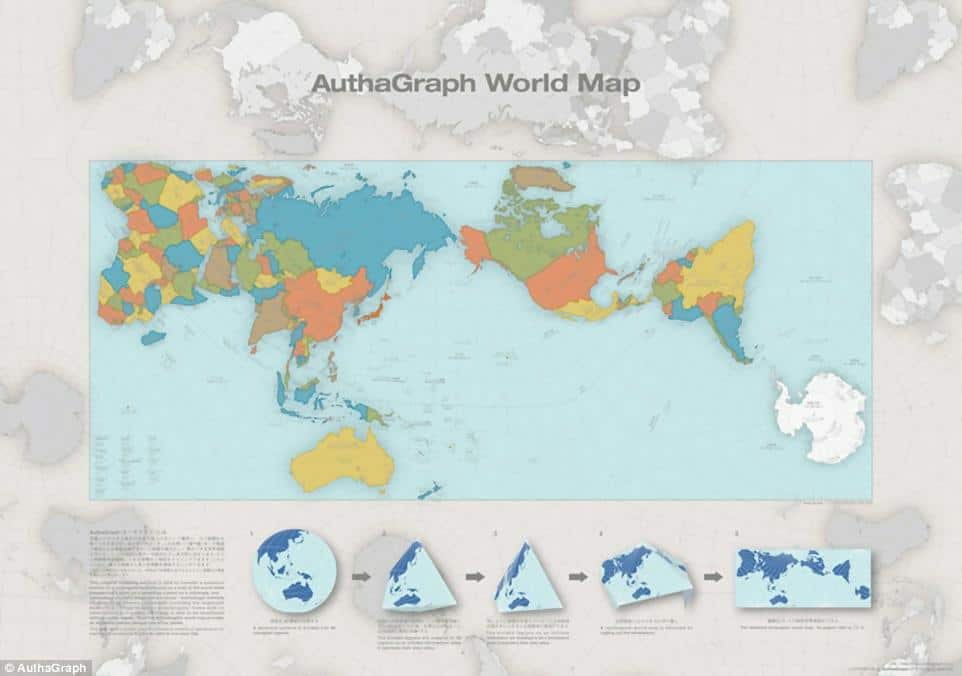
Satellites
Earth has one natural satellite the Moon, and several other artificial satellites such as asteroids or large rocks trapped by Earth’s gravity. They are trapped only temporarily for months or even years before returning to an orbit around the Sun.
It is believed that the Moon was formed after a collision billions of years ago. A large chunk of rock smashed into Earth and displaced a portion of Earth’s interior. The resulting chunks clumped together and formed our Moon. This is at least the most widespread theory, researching continues.
The Moon
Since ancient time’s humanity has used the moon to measure the passing of months due to its moving phases from full moon to new moon and back again.
It is called the moon because it was used to measure the months. The word moon can be traced to the Old English word “mōna.” It shares its origin with the Latin words “metri”, which means to measure, and “mensis”, which means month.

Earth’s moon is the fifth largest of all the moons in the solar system. The Moon is pretty big when comparing it to Earth, being a full quarter of the diameter of the planet. This is the biggest ratio, much bigger than for any other moon orbiting a planet.
The Moon has a diameter of about 3.470 km / 2. 156 mi, and on average it is about 380.000 km / 236.121 mi away from Earth. This means that 30 Earth’s could fit in between to cover the distance. The Moon has a radius of 1.079 mi / 1.737 km. It’s not even wider than the United States.
The Moon has a similar structure to that of the Earth: a solid iron inner core, a liquid outer core, a thick mantle, and a crust of lighter materials on the top.
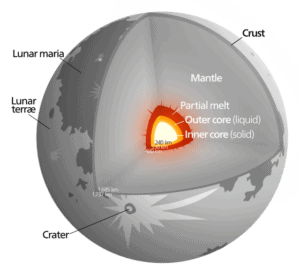
The core is believed to be around 350 km / 217 in radius with hot temperatures being present but not as high as in Earth’s core. The lower mantle may be a thick fluid, but unlike Earth’s mantle, the upper part is solid.
The Moon is tidally locked to Earth, meaning it always shows only one side of its surface to us. The side that we see called the near side is divided into two distinct types of regions:
- Highlands, which are heavily cratered
- Maria (Latin for seas), which are darker and smoother.
The Moon may as well act as a shield against space objects. The highlands were cratered by impacts over the eons from asteroid and comet collisions. Rocks from these regions have been dated to be about 4 billion years old, nearly as old as the Moon itself.
The maria region doesn’t have nearly as many craters. They are younger, appearing to be about 3.5 billion years old. The maria are made of darker, basaltic material, which means they probably formed from lava flooding older areas.

The dark side of the moon referred to as the “far side” remained a mystery for us for most of our existence. In 1959 the Soviet Union flew the Luna 3 space probe around the Moon, photographing the far side.
Expectations were that the far side would look like the near side. However, the far side was vastly different presenting almost no maria. The crust on the far side is thicker than on the near side.

The only explanation for this has to do with how the moon was formed. The most well-known theory is the Giant Impact hypothesis. A Mars-sized planet slammed into the young Earth, not head-on impact but rather a grazing collision.
The material from both planets was blasted into space and later formed the Moon. Though is it similar to Earth in composition, some rocks show a peculiar ratio of different kinds of oxygen atoms called isotopes, possibly being a piece of strong evidence for this theory. Further, the Moon was probably closer to Earth and suffered from Earth’s high temperatures at the time while the far side later suffered during the Late Heavy Bombardment.
There is a possibility that the Moon has water on it. Deep craters near the Moon’s poles have floors that never see sunlight. Comet impacts can distribute water all over the Moon, most of it being destroyed by the sunlight however, it can collect in these dark craters.
In fact, water was already discovered on the Moon but the water at the poles remains a bit hypothetical but very probable.
The Moon helps our planet be more livable by moderating Earth’s wobble on its axis, leading to a relatively steady climate. It also causes tides, creating a rhythm that has guided humanity for thousands of years.
The Moon used to have active volcanoes but now they are dormant. It also has a thin and weak atmosphere, called an exosphere.
Location
Earth, along with the Solar System, is situated in the Milky Way and orbits about 28,000 light-years from its center. It is about 20 light-years above the galactic plane in the Orion Arm.

The Future
The Earth is constantly gaining and losing mass with the Moon distancing itself from us one inch every year. Humanity must continue to strive and colonize other planets for survival as nothing lasts forever, especially finite materials.
In one billion years the solar luminosity will increase by about 10% causing the atmosphere to become a “moist greenhouse”, resulting in a runaway evaporation of the oceans. In about 2-3 billion years Earth’s magnetic dynamo may cease. Future missions for the colonization of the Moon are being prepared by several nations as well as other important missions to other worlds.
This hopefully will finally put an end to the flat Earth conspiracy and to the Moon flight conspiracy, and maybe humanity will realize its true capability and raison d’etre, with the hopeful success of future space missions.
Did you know?
- If all of Earth’s crustal surface were at the same elevation, the depth of the resulting ocean would be 2.7 km / 1.68 mi.
- The average salinity of Earth’s oceans is about 35 grams of salt per kilogram of seawater – 3.5% salt.
- The continents of Earth move at the same rate as human fingernails grow.
- The Moon and Earth orbit a common barycenter every 27.32 days relative to the background stars.
- The sphere of gravitational influence, of the Earth, is about 1.5 million km (930,000 mi) in radius. This is the maximum distance at which the Earth's gravitational influence is stronger than the more distant Sun and planets. Objects must orbit the Earth within this radius, or they can become unbound by the gravitational perturbation of the Sun.
- If space were a vacuum, Earth’s magnetic field would extend to infinity.
- The Moon orbits the Earth roughly as fast as a rifle bullet.
- The Earth is gradually rotating slower at about 17 milliseconds per 1.000 years. The Moon contributes to this and as Earth slows down, the Moon creeps away.
- The Earth’s magnetic field and its interaction with the solar wind also produce the Van Allen radiation belts, a pair of doughnut shaped rings of ionized gas (or plasma) trapped in orbit around the Earth.
- The Earth is travelling through space at roughly 67.000 miles 107,826 kilometers per hour.
- Earth has a lot fewer craters than the surface of most other planets. This is because the planet has lots of volcanoes and earthquakes which cause the highs and lows of the surface to sink or be worn down over time.
- Around 1.300.000 Earth’s could fit into the Sun.
- The Sun will eventually turn into a red giant and engulf Earth.
- The first picture taken of Earth from outer space was conducted by the Apollo 17 team. The original picture portrayed Earth upside-down. The image was later edited.
- If 7 billion people were to jump at the same time, a magnitude 4 to 8 earthquake would ensue.
- Light pollution prevents one third of Earth’s population from seeing the Milky Way galaxy in the night sky.
- The Moon has been visited by over 100 space probes.
- The rocks brought back by the Apollo 11 team from the moon are still studied to this day.
Sources:
Image sources:
- https://upload.wikimedia.org/wikipedia/commons/thumb/9/97/The_Earth_seen_from_Apollo_17.jpg/767px-The_Earth_seen_from_Apollo_17.jpg
- https://en.wikipedia.org/wiki/Heliocentrism#/media/File:Heliocentric.jpg
- https://www.universetoday.com/58177/earth-formation/
- https://www.xearththeory.com/wp-content/uploads/expanding-earth-7.jpg
- https://en.wikipedia.org/wiki/Solar_System#/media/File:Planets2013.svg
- https://en.wikipedia.org/wiki/Earth%27s_orbit#/media/File:Geoz_wb_en.svg
- https://en.wikipedia.org/wiki/Structure_of_the_Earth#/media/File:Earth_poster.svg
- https://en.wikipedia.org/wiki/Geology#/media/File:Active_Margin.svg
- https://en.wikipedia.org/wiki/Geology#/media/File:San_Andreas.jpg
- https://speculativeevolution.fandom.com/wiki/Novopangea?file=Novopangea.jpg
- https://upload.wikimedia.org/wikipedia/commons/thumb/6/69/Earth2014shape_SouthAmerica_small.jpg/661px-Earth2014shape_SouthAmerica_small.jpg
- https://upload.wikimedia.org/wikipedia/commons/d/df/Full_moon_partially_obscured_by_atmosphere.jpg
- https://ichef.bbci.co.uk/news/660/cpsprodpb/169F1/production/_84575629_magneticfield.jpg
- http://4k.com/wp-content/uploads/2015/12/oval.png
- https://en.wikipedia.org/wiki/Earth#/media/File:Earth_elevation_histogram_2.svg
- https://upload.wikimedia.org/wikipedia/commons/6/61/AxialTiltObliquity.png
- https://upload.wikimedia.org/wikipedia/commons/c/c8/PhylogeneticTree%2C_Woese_1990.svg
- https://upload.wikimedia.org/wikipedia/commons/thumb/4/48/Panspermie.svg/800px-Panspermie.svg.png
- https://www.dailymail.co.uk/sciencetech/article-3894600/The-map-shows-world-REALLY-looks-like-Japanese-design-flattens-Earth-big-landmasses-oceans-really-are.html
- https://upload.wikimedia.org/wikipedia/commons/thumb/e/e1/FullMoon2010.jpg/808px-FullMoon2010.jpg
- https://steemitimages.com/p/54TLbcUcnRm4iYtFdzVNy1kt3F2tvRShXkTnWxjMqVpHRnm2gJV24YjCgcjmRNxfuD6FVEdRmTwntCaQ3rLKaFLRQKEWJwFkzKbfzGCs91BWWJ8Q8WqqVqdWg625ziFL1dPEdhbeW?format=match&mode=fit&width=640
- https://swh-826d.kxcdn.com/wp-content/uploads/2011/04/Lunar-Maria.jpg
- https://images.theconversation.com/files/108549/original/image-20160119-29756-1frh5c9.jpg?ixlib=rb-1.1.0&q=45&auto=format&w=926&fit=clip
- https://en.wikipedia.org/wiki/Moon#/media/File:LRO_WAC_South_Pole_Mosaic.jpg
- https://en.wikipedia.org/wiki/Milky_Way#/media/File:Galactic_longitude.JPG
